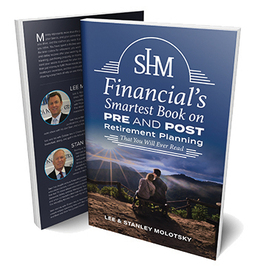
The father and son duo of SHM Financial Group has been navigating the waters of investing, retirement planning and more for over 65 years. Stan and Lee Molotsky have written two books, and SHM Financial’s Smartest Book on Pre and Post Retirement Planning that You Will Ever Read is their most recent. All of the book’s proceeds support the Jewish Federation of Southern Jersey’s special needs endowment fund.
SHM Financial Group has a motto: “Think positive – hope for the best but prepare for the worst.” With that being said, Stan and Lee offer advice for those getting ready to send their kids off to college.
“Do yourself a favor and complete these documents,” says Stan. First off, as guardians and parents it’s important to make sure you have access to your children’s medical and financial records. Universal HIPPA release forms allow important medical information to be shared; health care proxy or health care power of attorney forms allow someone to act on behalf of someone who is unable to act for themselves; FERPA waiver forms allow parents or whoever is paying tuition access to their child’s grades and school records; health insurance – young people can stay on parents’ plans in most cases until age 26, however some people may elect to purchase college plans that might be less expensive; durable power of attorney for finances allows parents to step in to help financially without seeking judicial permission to act on a child’s behalf; if a medical crisis does occur you want to be ready with a living will that allows young adults to spell out ahead of time what would be acceptable to them. These forms are readily available from your attorney or even online in some cases. Having these forms in place helps in providing peace of mind.
Investing in a changed world
Think carefully about not investing in your 401(k), Stan says. “Bad 401(k)s limit options while charging high fees. Low-fee taxable brokerage accounts and IRAs are worth considering, especially ones that guarantee a return. Limit your fees as much as possible. Over your working lifetime it becomes a staggering amount.”
He adds some other helpful tips about investing. “Stimulus programs over the past few years have helped businesses and people stay afloat, but free money is rarely free. Today living is more expensive. If you needed $85,000 in 2010, you would need $101,000 to have the same buying power today. In terms of saving, always look for the investments that can increase with inflation.”
In the past, Molotsky notes, putting funds into real estate, gold, precious metals and commodities like lumber and food staples have paid off.
“Think twice before buying stocks,” he says. “Whether you are new or experienced at investing, it is best to focus on companies that thrive when times get hard. Build your watch list of shares you would someday like to own. You will then be ready to act.
Finally, he stresses the importance of updating your will.
“Don’t leave your plan for distribution of assets up in the air,” he says. “It’s important that your will is up to date and you have the proper powers of attorney.”
Retirement planning
Retirement planning is a heady, deeply personal and infinitely individualized process. Molotsky says it can be distilled into a basic approach – L.I.V.E. – longevity, inflation, volatility and events.
“You have to look at your retirement plan and make tweaks to it as you move along,” he explains. “Make sure you have a team of people – your CPA, your attorney and a financial advisor – who you can utilize to help you implement the things you want to do. You can only do so much yourself.”
Stan says you have red money and green money. “The red money has risk and a greater chance of return but also has the possibility of loss. The green money is protected and will be there no matter what. At SHM, we’ll keep looking at your risk tolerance and making adjustments along the way.
“As you get closer to retirement and the first year or two into retirement, one of the things you’ll want to do is make sure you have enough liquid assets available to you in a short period of time to get you through six, 12, 18 or 24 months without having to touch your core investments.”
Maximizing Social Security will provide a benefit. “Everyone’s different, as far as whether you should wait until you’re 72, take it at 70 or take it at 65,” he says. “And there are different things you can utilize based on what your other assets are to tell you if you should take it earlier or later. When you’re in your 60s and you’re just staring to look at what you might want to do, you have to consider that the longer you wait, the higher the number will be, but if you take it earlier you have the use of the money, which you could invest and hopefully do as well if not better in generating a higher income.”
Whatever your current and future goals are, give the team at SHM Financial Group a call for a plan and most of all for peace of mind.
SHM Financial
1010 Haddonfield-Berlin Road l Suite 305 l Voorhees
SHM Building l 100 Richey Avenue l Collingswood
(800) MONEY-SHM
SHMFinancial.com
Published (and copyrighted) in Suburban Family Magazine, Volume 14, Issue 8.
For more info on Suburban Family Magazine, click here.
For information about advertising in Suburban Family Magazine, click here.
To find out where to pick up your copy of Suburban Family Magazine, click here.




